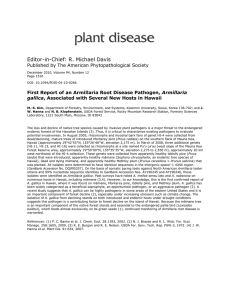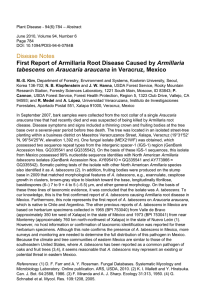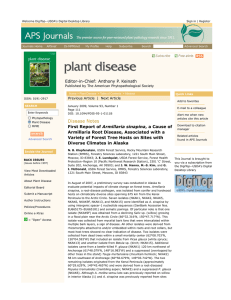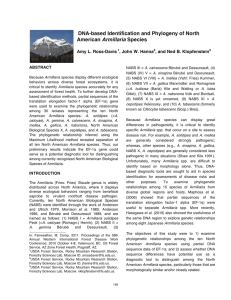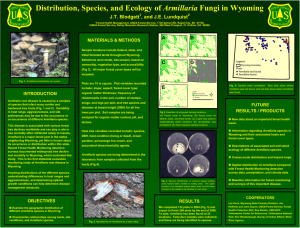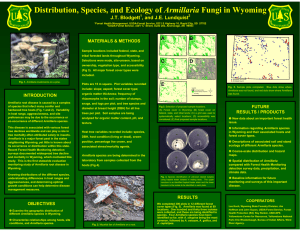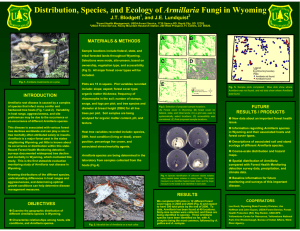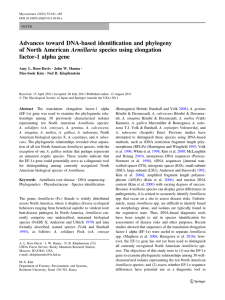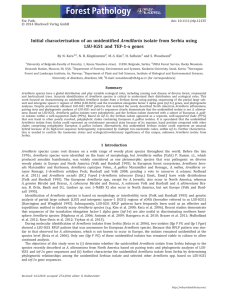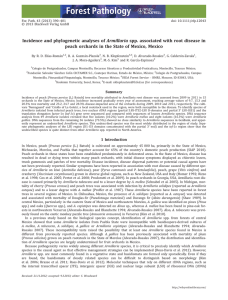ARMILLARIA ONGOING DIVERGENT SPECIATION WITHIN THE BOREAL FLORISTIC KINGDOM
advertisement
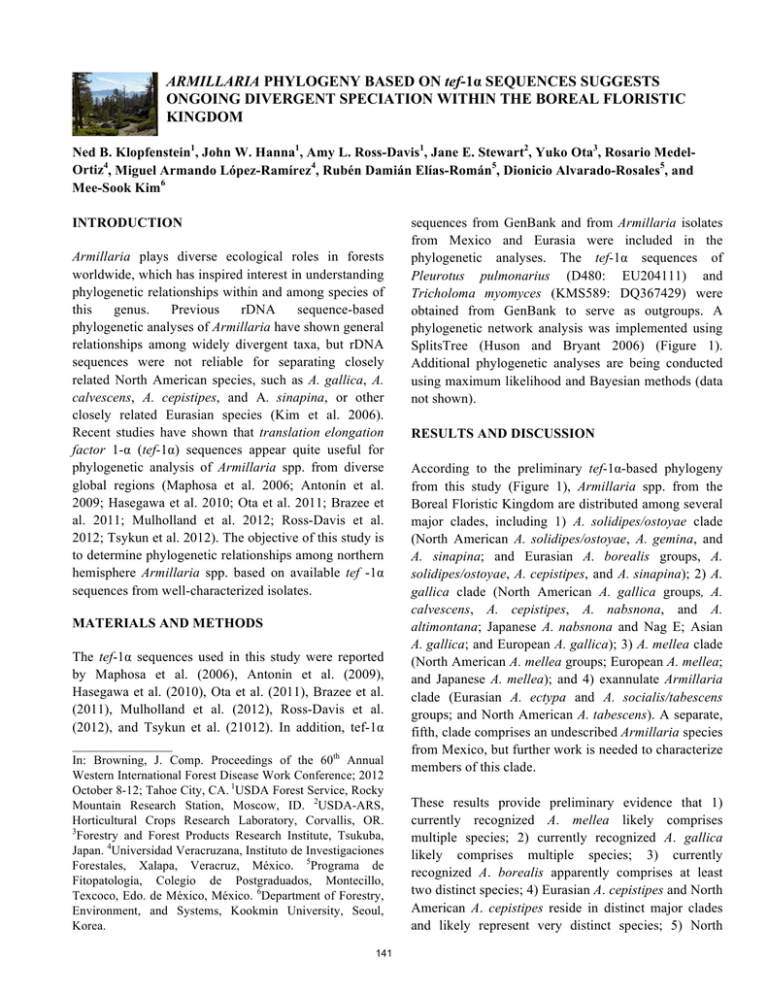
ARMILLARIA PHYLOGENY BASED ON tef-1α SEQUENCES SUGGESTS ONGOING DIVERGENT SPECIATION WITHIN THE BOREAL FLORISTIC KINGDOM Ned B. Klopfenstein1, John W. Hanna1, Amy L. Ross-Davis1, Jane E. Stewart2, Yuko Ota3, Rosario MedelOrtiz4, Miguel Armando López-Ramírez4, Rubén Damián Elías-Román5, Dionicio Alvarado-Rosales5, and Mee-Sook Kim6 INTRODUCTION Armillaria plays diverse ecological roles in forests worldwide, which has inspired interest in understanding phylogenetic relationships within and among species of this genus. Previous rDNA sequence-based phylogenetic analyses of Armillaria have shown general relationships among widely divergent taxa, but rDNA sequences were not reliable for separating closely related North American species, such as A. gallica, A. calvescens, A. cepistipes, and A. sinapina, or other closely related Eurasian species (Kim et al. 2006). Recent studies have shown that translation elongation factor 1-α (tef-1α) sequences appear quite useful for phylogenetic analysis of Armillaria spp. from diverse global regions (Maphosa et al. 2006; Antonín et al. 2009; Hasegawa et al. 2010; Ota et al. 2011; Brazee et al. 2011; Mulholland et al. 2012; Ross-Davis et al. 2012; Tsykun et al. 2012). The objective of this study is to determine phylogenetic relationships among northern hemisphere Armillaria spp. based on available tef -1α sequences from well-characterized isolates. MATERIALS AND METHODS The tef-1α sequences used in this study were reported by Maphosa et al. (2006), Antonin et al. (2009), Hasegawa et al. (2010), Ota et al. (2011), Brazee et al. (2011), Mulholland et al. (2012), Ross-Davis et al. (2012), and Tsykun et al. (21012). In addition, tef-1α ________________ In: Browning, J. Comp. Proceedings of the 60th Annual Western International Forest Disease Work Conference; 2012 October 8-12; Tahoe City, CA. 1USDA Forest Service, Rocky Mountain Research Station, Moscow, ID. 2USDA-ARS, Horticultural Crops Research Laboratory, Corvallis, OR. 3 Forestry and Forest Products Research Institute, Tsukuba, Japan. 4Universidad Veracruzana, Instituto de Investigaciones Forestales, Xalapa, Veracruz, México. 5Programa de Fitopatología, Colegio de Postgraduados, Montecillo, Texcoco, Edo. de México, México. 6Department of Forestry, Environment, and Systems, Kookmin University, Seoul, Korea. 141 sequences from GenBank and from Armillaria isolates from Mexico and Eurasia were included in the phylogenetic analyses. The tef-1α sequences of Pleurotus pulmonarius (D480: EU204111) and Tricholoma myomyces (KMS589: DQ367429) were obtained from GenBank to serve as outgroups. A phylogenetic network analysis was implemented using SplitsTree (Huson and Bryant 2006) (Figure 1). Additional phylogenetic analyses are being conducted using maximum likelihood and Bayesian methods (data not shown). RESULTS AND DISCUSSION According to the preliminary tef-1α-based phylogeny from this study (Figure 1), Armillaria spp. from the Boreal Floristic Kingdom are distributed among several major clades, including 1) A. solidipes/ostoyae clade (North American A. solidipes/ostoyae, A. gemina, and A. sinapina; and Eurasian A. borealis groups, A. solidipes/ostoyae, A. cepistipes, and A. sinapina); 2) A. gallica clade (North American A. gallica groups, A. calvescens, A. cepistipes, A. nabsnona, and A. altimontana; Japanese A. nabsnona and Nag E; Asian A. gallica; and European A. gallica); 3) A. mellea clade (North American A. mellea groups; European A. mellea; and Japanese A. mellea); and 4) exannulate Armillaria clade (Eurasian A. ectypa and A. socialis/tabescens groups; and North American A. tabescens). A separate, fifth, clade comprises an undescribed Armillaria species from Mexico, but further work is needed to characterize members of this clade. These results provide preliminary evidence that 1) currently recognized A. mellea likely comprises multiple species; 2) currently recognized A. gallica likely comprises multiple species; 3) currently recognized A. borealis apparently comprises at least two distinct species; 4) Eurasian A. cepistipes and North American A. cepistipes reside in distinct major clades and likely represent very distinct species; 5) North American A. solidipes/ostoyae is genetically distinct from Eurasian A. solidipes/ostoyae; 6) North American A. socialis/tabescens appears phylogenically distinct from Eurasian A. socialis/tabescens; 7) a well-separated clade comprises Armillaria isolates from Mexico that represent an undescribed species (Elias-Roman et al. this proceedings); and 8) the genus Armillaria likely comprises multiple other cryptic species. Continued phylogenetic studies are needed to confirm genetic relationships within the Armillaria genus. Figure 1. SplitsTree phylogenetic network of global Armillaria spp., based on translation elongation factor 1-α. 142 REFERENCES Antonín, V.; Tomšovský, M.; Sedlák, P. and others. 2009. Morphological and molecular characterization of the Armillaria cepistipes – A. gallica complex in the Czech Republic and Slovakia. Mycological Progress. 8:259-271. Brazee, N.J.; Hulvey, J.P.; Wick, R.L. 2011. Evaluation of partial tef1, rpb2, and nLSU sequences for identification of isolates representing Armillaria calvescens and Armillaria gallica from northeastern North America. Fungal Biology. 115:741-749. Hasegawa, E.; Ota, Y.; Hattori, T.; Kikuchi, T. 2010.Sequence-based identification of Japanese Armillaria species using elongation factor-1 alpha gene. Mycologia. 102:898-910. Maphosa, L.; Wingfield, B.D.; Coetzee, M.P.A. and others. 2006. Phylogenetic relationships among Armillaria species inferred from partial elongation factor 1-alpha DNA sequence data. Australasian Plant Pathology. 35:513-520. Mulholland, V.; MacAskill, G.A.; Laue, B.E. and others. 2012. Development and verification of a diagnostic assay based on EF-1α for the identification of Armillaria species in Northern Europe. Forest Pathology. 42:229-238. Ota, Y.; Kim, M.-S.; Neda, H. and others. 2011. The phylogenetic position of an Armillaria species from Amami-Oshima, a subtropical island of Japan, based on elongation factor and ITS sequence. Mycoscience. 52:53-58. Ross-Davis, A.L.; Hanna, J.W.; Kim, M.-S.; Klopfenstein, N.B. 2012. Advances toward DNA-based identification and phylogeny of North American Armillaria species using elongation factor-1 alpha gene. Mycoscience. 53:161-165. Huson, D.H.; Bryant, D. 2006. Application of phylogenetic networks in evolutionary studies. Molecular Biology and Evolution. 23:254-267. Kim, M.-S.; Klopfenstein, N.B.; Hanna, J.W.; McDonald, G.I. 2006. Characterization of North American Armillaria species: genetic relationships determined by ribosomal DNA sequences and AFLP markers. Forest Pathology. 36:145-164. Tsykun, T.; Rigling, D.; Nikolaychuk, V.; Prospero, S. 2011. Diversity and ecology of Armillaria species in virgin forests in the Ukrainian Carpathians. Mycological Progress. 11:403-413. 143 144
